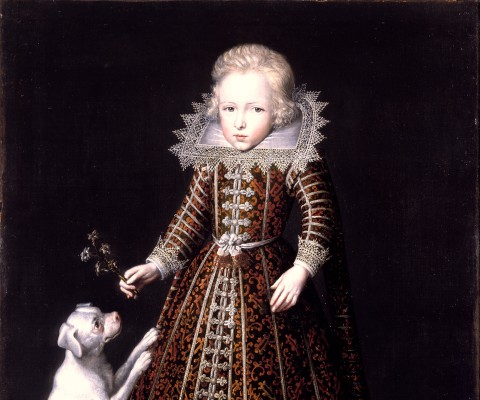Duke Ulrik returned home
Wednesday 17 November Jacob van Doordts beautiful portrait of Duke Ulrik officially returned home to Denmark.
At a ceremony in the Winter Room in Christian 4.s favorite castle, the portrait was unveiled by Their Royal Highnesses the Prince Consort of Denmark and Prince Christian.
The picture was painted around 1615 and depicts the only four-year Duke Ulrik, who was Christian 4.s fourth son with Queen Anne Cathrine.
The acquisition of the portrait has been made possible thanks to support from the Augustinus Foundation.
Duke Ulrik
Duke Ulrik was the youngest of the 4 sons that Christian IV had with his queen, Anna Cathrine of Brandenburg. The king also had two daughters with her, but both died in infancy.
Before 1660 the kingdom of Denmark was still an elective kingdom. Ulrik’s eldest brother Christian was therefore the “Prince Elect”, i.e. the elected successor to the throne, but he died in 1647, a year before his father, Christian IV. It was therefore Ulrik’s second eldest brother who became king, as Frederik III, in 1648. The king’s other territories, the Duchies of Schleswig and Holstein, were hereditary, however, and for that reason Ulrik has the title of “Duke”.
Since Ulrik was not successor to the throne, he had to be brought up to live another kind of life. The choice fell on a traditional education with the academic learning that would be expected of a royal son, including everything from book learning to the military. This background made it possible for him to work for his father the king, but also for foreign courts and armies. He served as an officer in Sweden, Holland and Saxony. In 1632 he managed to regain Tycho Brahe’s globe, which had previously been carried off to Silesia – Ulrik was at that time only 21 years old! But his main interests were in philosophy, righteous living and various forms of art, including poetry and painting.
Unfortunately Duke Ulrik died young, at the age of just 23, in 1633. He may have been shot in battle, or killed by an assassin, or by a stray shot; there are several different versions.
He has left us with an outline of a true renaissance prince and of a young person who achieved much in a very short time. In royal circles at the time he was highly spoken of, and the sense of loss at his death was deeply felt among them.
The Portrait
Portrait of Duke Ulrik (1611-33), painted by Jacob van Doort, who painted a number of portraits for the Danish court in Christian IV’s time. Van Doort also worked for several other European kings and princely houses.
The portrait must have been painted in around 1615, when the duke would have been about 4 years old – this can be deduced mainly from the garments depicted.
The painting is a formal portrait containing several symbols that tell us about the subject of the portrait.
On the left side there is a little white Chinese pug – a type of dog that was popular at European courts, mainly because it was rare.
Another symbol is the white hyacinth which Duke Ulrik is holding in his hand. The hyacinth was at that time a rare and expensive flower. One has to suppose that the fact that it is placed in the boy’s hand symbolises his future possibilities for wealth and honour in his journey through life.
There are no directly corresponding paintings of Christian IV’s other children. It can be assumed, however, that all those who were legitimate or who were accepted at court would have had their portraits painted, but those paintings have not been preserved.
The other preserved portraits of Duke Ulrik show him either as an older child or as a young man. This painting therefore has a specially important role, because it contributes to making up a full series of portraits of a royal child in the Renaissance.
Duke Ulrik’s garments
The portrait is fascinating, not least because of its very detailed depiction of the boy’s garments. Royal portraits often show luxurious materials, lace and trimmings so realistically that one can be in no doubt about the quality of the textiles.
The garment is a dress, and would have been the same for boys and girls until the age of 6. The bodice is close-fitting (worn over a corset, which even small children also wore), and the skirt reaches down to the ground. The garment has long decorative hanging sleeves, which were also to be found on adult garments – but they had the added function that on a child’s dress they could be used to guide the child when he/she was learning to walk.
The seams of the garment are decorated with narrow woven bands of silver thread, and the dress fastens in the centre front with braided fastenings and decorative buttons and loops. The buttons are sewn from silver thread in a chessboard pattern covering a little wooden ball. This form of fastening was used on garments of especially fine or heavy material, because in that way one could avoid making buttonholes in the material. This also meant that the material could later be re-used. Moreover, the buttons and loops are more flexible than buttons and buttonholes – useful when one is growing.
Duke Ulrik’s white collar sits right up around his ears, kept in position by a kind of frame called a supportasse. Just a few years later the fashions changed and men preferred to have longer hair, so the collar had to be lowered to lie on the shoulders, to make room for the hair.
The presentation of the painting has been generously supported by:

 Dansk
Dansk
 English
English
 Deutsch
Deutsch

